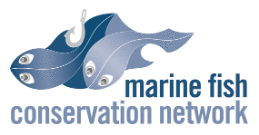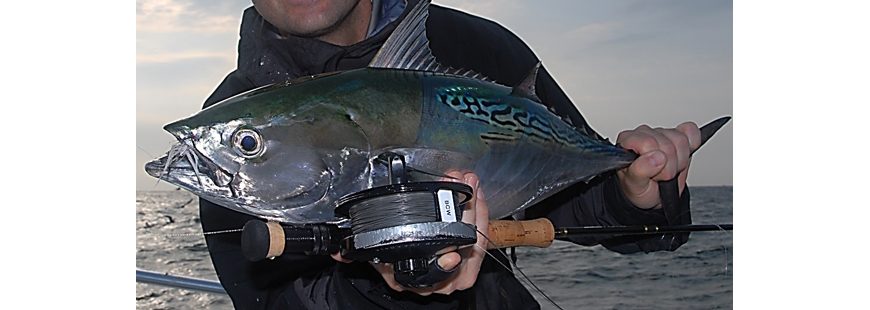False albacore photo by John McMurray
For a very long time, the false albacore was a sort of fishy pariah.
There was no significant market for their bloody, strong-tasting meat, which was also a turnoff to anglers, who cursed when the fish crashed lures meant for one of the better-tasting tunas. A few recreational fishermen enjoyed their hard fight, but at a time when small, “school” bluefin still swarmed just few miles offshore, Atlantic bonito were common, and inshore anglers could find plenty of striped bass, red drum, and bluefish, false albacore weren’t many anglers’ favorite species.
They were even identified by what they were not, called “false” albacore, to contrast them with what anglers deemed “true” or “longfin” albacore, a tasty, white-meat tuna that just about every fisherman was happy to ice and take home. If anyone down on the docks had referred to them by their proper name, “little tunny,” they would have just gotten most folks confused.
But things changed.
Saltwater fly fishing and light-tackle angling became more and more popular, and anglers who employed such gear began to widen their horizons, willing to cast to any sort of fish that ran fast and pulled hard. False albacore certainly fit the bill, and in places like Nantucket and Martha’s Vineyard, Massachusetts, Montauk, New York, and Harker’s Island, North Carolina, a new industry sprung up that saw charter boat captains taking to the water in small, fast boats, to chase down schools of false albacore that could be caught, and subsequently released, on their clients’ favored gear. These charter boat captains often called themselves “light tackle guides” to distinguish their operations from those of the traditional “six-pack” fleet that ground away with sturdy rods and heavy lines, in an effort to kill and keep as many fish as possible.
Suddenly, false albacore were in the spotlight. Anglers were willing to travel hundreds of miles, and spend thousands of dollars, just to cast a fly or toss a lure to fish that went all but ignored a few years before.
As the striped bass population declined and bluefish grew scarcer, the ability to put clients on false albacore became even more important. Nearly a decade ago, Capt. David Blinken, a long-time Montauk guide, asked that the Mid-Atlantic Fishery Management Council (Mid-Atlantic Council) provide false albacore some protection, noting that “albies give us a shot at diversity. Since the demise of the striped bass fishery we rely on them to satisfy our clients.”
The Mid-Atlantic Council did not heed his call. Since then, the striped bass fishing has only gotten worse, which has made false albacore even more important to the recreational fishing industry.
But an issue lurked in the background. Although false albacore range along much of the East Coast, from Massachusetts to Florida and then throughout the Gulf of Mexico, and are very common outside the United States as well, not much was known about them. For a while, the South Atlantic Fishery Management Council (South Atlantic Council) included them in its Coastal Migratory Pelagics Fishery Management Plan, but in 2011 they were removed from that plan because the South Atlantic Council no longer believed that the stock was “in need of conservation and management,” as required by the Magnuson-Stevens Fishery Conservation and Management Act. No other regional or national management body had attempted to govern the fishery.
No one knew whether the false albacore caught off New England, New York, North Carolina, and Florida were part of the same stock of fish, or belonged to reproductively distinct populations. And no one had any idea whether increasing fishing pressure in the southeast might affect fish elsewhere on the coast.
That became an issue, because commercial fisheries for false albacore slowly began to develop. Although the meat wasn’t traditionally eaten in the United States, it was consumed elsewhere in the western hemisphere; similar species also swim in the Pacific Ocean, and support fisheries there. Thus, as people from those areas came to the U.S., market demand for false albacore increased. False albacore has also become a popular bait that is cut into pieces to catch dolphin, snapper, and other smaller fish, or sliced into long strips to attract bigger species such as swordfish, sharks, and goliath grouper.
From 1950 through 1994, commercial false albacore landings were scattered among the various East Coast states, although only North Carolina had annual landings exceeding 100,000 pounds on a regular basis. Beginning in 1995, Florida began recording significant landings, and was soon exceeding 300,000 pounds per year, while North Carolina’s annual landings generally remained between 100,000 and 200,000 pounds. In 2003, Florida’s commercial false albacore landings exceeded 1,000,000 pounds for the first time, and although the state’s landings fell back substantially after that, Florida remains the dominant player in the commercial false albacore fishery, with North Carolina not too far behind.
Both anglers and the guides whom they fished with grew concerned that the commercial landings might harm the recreational false albacore fishery, but they had no data that they could use to either justify or allay their concerns.
The American Saltwater Guides Association (ASGA), which had already seen its members hurt by a decline in striped bass and bluefish abundance, recognized that “Our guides and fishing-related businesses on the Atlantic coast can’t afford to lose another species,” and became the false albacore’s primary, and arguably only, advocate.
ASGA’s efforts began in 2022, after it found a group of sponsors willing to fund a tagging study that would be conducted by Dr. Jeff Kneebone of the New England Aquarium. Working from boats operated by ASGA members, Dr. Kneebone’s team implanted 50 acoustic tags in false albacore caught in Nantucket Sound during the first year of the study. Another 97 false albacore were tagged in 2023.
Scientists, working on many different projects, have deployed acoustic receiver arrays all along the coast between southern Canada and the U.S./Mexico border, and typically share their data. Whenever one of the tagged false albacore passes near an array, its tag will transmit a unique identifier to the receiver, and Dr. Kneebone will be notified. That will eventually provide him with important information on the timing and extent of false albacore migrations, and also help him to determine whether all of the false albacore on the coast belong to a single stock, or whether they constitute separate regional populations.
ASGA also worked with the National Marine Fisheries Service’s Southeast Fisheries Science Center (Science Center) to develop a tagging program using conventional “spaghetti” tags, streamers of plastic that are anchored in the muscle of the false albacore. Each tag is imprinted with a unique number, along with brief instructions on how to return it to the Science Center.
Spaghetti tags are cheap, particularly when compared to acoustic tags that cost hundreds of dollars apiece, and so large numbers of them can be deployed. Such volume is necessary, because unlike acoustic tags, which need only pass by a receiver to record a fish’s movements, spaghetti tags require that the tagged fish be recaptured and reported by a fisherman; that only happens with a small minority of the fish tagged. Thanks to ASGA’s widespread membership, there were many guides, located in ports between New England and Florida, who were willing to help out and tag their clients’ false albacore and so contribute to the false albacore study.
The tagging efforts are already showing results. It appears that all of the false albacore on the U.S. East Coast constitute a single stock, as fish tagged in Nantucket Sound have been detected by receivers as far away as the southernmost tip of the Florida Keys, with particular concentrations off southern New England, eastern Long Island, North Carolina, and southeast Florida.
A DNA study, also supported by ASGA, lent additional credence to the single-stock hypothesis. Researcher Steven Bogdanowicz analyzed samples provided from false albacore caught off Massachusetts, New York, and North Carolina, utilizing two different software packages to evaluate the results. He noted that, ”we didn’t set out to determine whether fish from MA/NY/NC were different from each other; rather we’re asking ‘If we take a sample of albies from a pretty broad area at about the same time, how many genetic groups do we see?’”
As it turned out, both software packages suggested that, in the entire expanse of coastal sea between Massachusetts and North Carolina, all false albacore belonged to the same genetic group. Thus, should overfishing occur anywhere along the coast, it could impact the entire false albacore population.
With that information in hand, ASGA began to advocate for precautionary false albacore management.
It first approached the South Atlantic Council, which had, for a brief time, managed the species. ASGA argued that the South Atlantic Council’s 2011 finding that the stock was not in need of conservation and management was outdated, and should be reconsidered. In response, the South Atlantic Council’s Mackerel-Cobia Committee (Committee) drafted a white paper which was intended to be a preliminary examination of whether the species met Magnuson-Stevens’ ten criteria for management.
The analysis suggested that false albacore met four of the ten criteria, and may have met a few others, but that the stock “has not been assessed and as a result the stock condition is not well understood. However, there is no other available information suggesting that the stocks may be in a depleted or otherwise diminished condition, or that management is necessary to address such conditions.”
In the end, the Committee directed South Atlantic Council staff to provide a Fishery Performance Report for false albacore every three years, which would allow the Committee to keep a closer watch on the fishery, and perhaps spur action if fishing mortality spiked.
After that modest success, ASGA encouraged the Atlantic States Marine Fisheries Commission (ASMFC) to consider false albacore management. The issue was first discussed at the February 2, 2023 meeting of ASMFC’s Interstate Fishery Management Program Policy Board (Policy Board), where it received the support of some state fisheries directors. The Policy Board’s then chairman, “Spud” Woodward, the Governor’s appointee from Georgia, noted that both false albacore and Atlantic bonito “are sort of in this, what I would call under-loved tunas’ category right now,” and opined that “We really need to look at both of them, because the South Atlantic Council was approached by the American Saltwater Guides Association about bringing both of them under Magnuson-Stevens Act management…There really wasn’t any appetite, because most of the fishery is occurring in state waters…we probably need to consider both of these species, if we’re going to move forward.”
However, the Policy Board walked away from the issue at its May 3, 2023 meeting. The ASMFC’s fisheries policy director, Toni Kearns, warned that if the ASMFC was asked to manage any additional species, “We would probably either need to have another ISMFP staff member, and possibly a new stock assessment scientist, or we would need to have measurable changes in the current species priorities for both management and stock assessments.” Erika Burgess, a Florida fisheries manager, noted that Florida was responsible for more than half of all false albacore landings, had looked at the management issue multiple times, and saw no need for managing the species, whether through the ASMFC or otherwise. Other state representatives also voiced their opposition.
In the end, the Policy Board took no action, and left the matter up to the states.
And, over the past few months, the states have accepted the challenge.
North Carolina was the first to act. On March 12, 2025, after holding a series of meetings and receiving extensive public comment, much of it driven by ASGA’s advocacy efforts in favor of precautionary false albacore management measures, the North Carolina Marine Resources Commission voted 5-4 to adopt new regulations to protect false albacore.
The new rules do not immediately create new restrictions on the false albacore fishery. Instead, should landings in any year rise above 200 percent of the average combined commercial and recreational landings for the years 2018 through 2022, the director of the Division of Marine Fisheries may issue a proclamation establishing a 3,500-pound trip limit for commercial vessels and a recreational bag limit of 10 false albacore per person, and no more than 30 false albacore per recreational vessel.
While such regulations seem lenient, they are sufficient to prevent false albacore from succumbing to an explosive increase in landings. As the first significant restrictions on false albacore landings anywhere along the coast, they constitute an important precedent for future management action. But in Massachusetts, fisheries managers are moving toward much more conservative management.
Dan McKiernan, the director of the Massachusetts Division of Marine Fisheries, has long been concerned with maintaining the health of the Atlantic bonito stock. He first raised the issue at the February 2, 2023 meeting of the Policy Board, initiating the discussion which eventually led to the Policy Board’s short-lived consideration of false albacore management. Thus, it was hardly surprising when Massachusetts, urged on by ASGA and other concerned recreational fishermen, began to consider regulations to limit the harvest of both species.
Nor was it surprising that, on March 27, 2025, the Division of Marine Fisheries approved regulations which established a five-fish aggregate bag limit for false albacore and Atlantic bonito (with an exception for fish caught by commercial mackerel-jigging vessels) as well as a 16-inch (fork length) minimum size for both species. While such regulations are not yet final, and must progress through Massachusetts’ rulemaking process, there is no reason to believe that they will not be put in place.
False albacore regulation is expected to gain momentum, particularly in the Northeast. ASGA has spoken to a number of state fisheries managers, and has generally found a good reception.
At the March 11, 2025 meeting of New York’s Marine Resources Advisory Council, Martin Gary, the director of the Department of Environmental Conservation’s Marine Resources Division, broached the topic, hoping to get the councilors’ initial reactions. The discussion was short, with one councilor representing the recreational sector strongly in favor, and one commercial councilor largely indifferent (although he thought that a 16-inch size limit for Atlantic bonito might be too high). The only opposition came from a party boat captain notorious for opposing any efforts to regulate fisheries, who deemed false albacore management a waste of time.
Despite such naysayers, the growing importance of false albacore to the recreational fishing industry can’t be denied. As other important sport fisheries decline, it only makes sense to adopt precautionary measures intended to maintain the health of the false albacore stock. For as ASGA has already noted, “guides and fishing-related businesses on the Atlantic coast can’t afford to lose another species.”
Effective, precautionary management, adopted in time, can help to ensure that they won’t.



You don’t have a clue what you’re talking about. False albacore is a trash fish and always will be. Stop trying to hype them up because you can’t catch anything else.